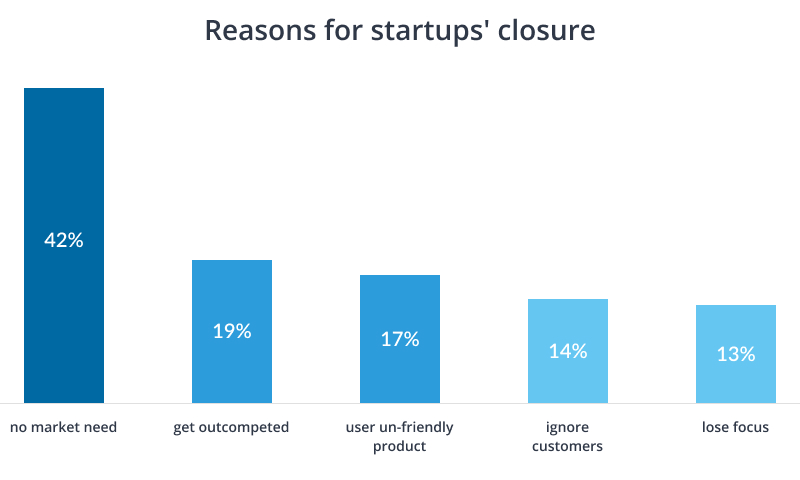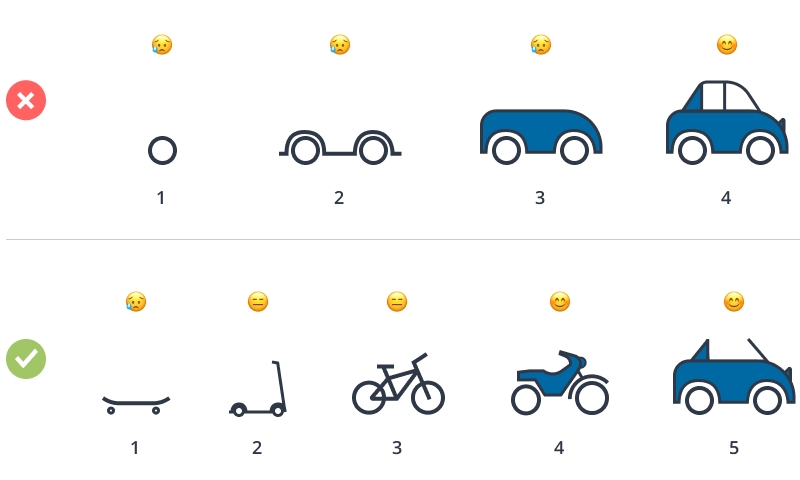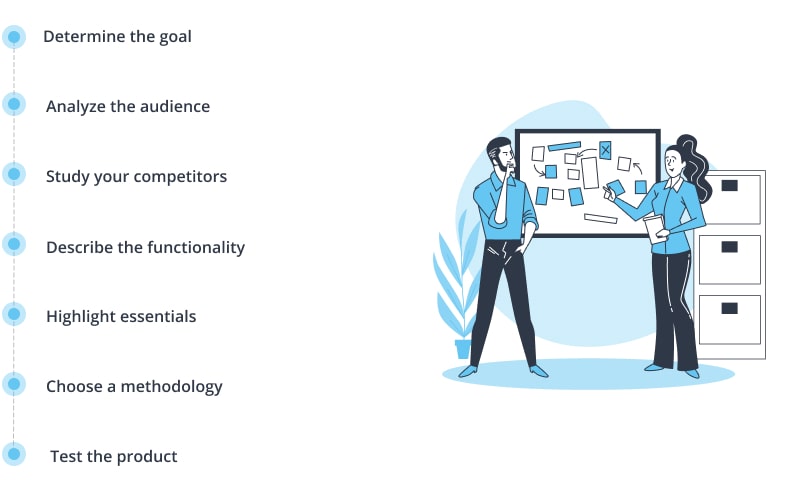Minimum Viable Product: Survival Guide

IT copywriter
Reading time:
To launch a new series, directors shoot a pilot episode that has all the “basic settings”. Feedback from the audience about the episode’s plot, characters and atmosphere allows creators to understand what’s working and what needs to be improved. The same goes for IT projects. To build a fully-fledged software product, you need to start with an MVP – minimum viable product. The MVP significantly affects the future of an app. In this article we will tell you how to make a tenacious MVP from a small idea that will become an amazing fully-fledged product.
What is MVP
According to Investopedia, 90% of startups close within the first year. 42% of these fail due to lack of demand. Other reasons why businesses fail include:

Most of these problems could have been avoided through careful planning in the early stages. Any entrepreneur should take advantage of a minimum viable product. This is the simplest version of a product with a basic set of features. An MVP can help validate the idea early in the process of product development. In this article we will talk about mobile apps and their basic versions.
The MVP is a scaled back version of a final product that gives the idea of the future result. It can be used to obtain reliable market research data and understand the further development direction. To have a better understanding of what the MVP is, have a look at the picture below. The top half of the image shows what an MVP isn’t; the lower half is a better representation of what an MVP is:
Why you need an MVP
An MVP is crucial for anyone who wants to approach the development of a new app carefully and rationally. It helps avoid numerous mistakes and gives advantages over those who create the entire product without testing different models.
- You will check the viability of your application without spending a lot of time, effort and money on it. If the audience is not interested in your product, then you will not have to regret the excessive investment. Thus, you will move in the right direction.
- You will get to know your audience better. You will find out whether people need your product, and if they do, why and how they would use it.
- You will understand what you have worked on enough, and where you need changes. In some cases, you will have to entirely redesign the app or its parts due to negative feedback. But this is for the best because it will allow you to develop a high-demand app.
- If the MVP launch is successful, you will get your first profit and customers long before creating the final version. In this way, you will quickly get a return on investment and find people who are more likely to become your regular users.
In addition, people may not need some features that you planned to pay special attention to. This will reduce the overall cost and time required for development and allow you to focus on primary needs of your audience.
When to use an MVP
Before working on an MVP, you need to build hypotheses to confirm or disprove. Hence, you will not just run the demo version of an app: you will understand what you need to add or remove, depending on the reactions of your users. Do this as early as possible. Your idea may be great, but if its implementation does not suit the audience, then you have to fix it as soon as you can.
MVP examples
A lot of prosperous businesses started with the development of a minimum viable product. For example, when WhatsApp was first released, it did not allow users to send messages. The idea was different: it was an interactive address book with current statuses (busy, available, driving, etc.). Users could update their statuses to let their contacts know whether they are ready to talk. The first users started to communicate using these statuses, so the app creators decided to add messaging functionality. Now WhatsApp has 1.6 billion active users.
Another example is Uber. Initially, its creators, disappointed with the prices of driving around the city, offered users the opportunity to rent limousines. It cost about 1.5 times as much as a cab, but ordering a car was as simple as sending a text or pressing a button. The product turned out to be much more in demand than expected, although it covered an audience in a limited area. Realizing this, the creators developed the idea and quickly received investments to expand Uber worldwide.
A one-page website with photos of a flat can also become a huge profitable business. Using such a landing page, developers who couldn’t pay their rent in San Francisco wanted to check if anyone was interested in renting rooms directly from owners. As it turned out, they were! This small project has grown into the website Airbnb, where people rent housing from owners, without wasting time and money on realtors and filling out documents.
How to create an MVP
Step 1. Determine a goal
Your idea should be interesting not only for you. Your product is user-centric first, so try to invent a way to simplify (or maybe change forever!) people’s lives.
Step 2. Analyze your target audience
After selecting an idea, you can conduct marketing research. You must have a good understanding of the psychology of your audience. If you’re targeting young people, keep in mind that they consume a lot loads of content daily. The best approach in that case would be to focus on not overloading the app and on making it catchy. If your target audience is high-profile business people, remember that they value time. Make your product easy to interact with. If you are creating an app with recipes for housewives, make them feel like they own the most beautiful and convenient cookbook in the world.
Step 3. Research your competitors
It’s very likely that someone has already implemented your idea before you but that’s okay! Eventually, people will choose what they like best, so your chances of success are still high. However, you must clearly understand the strengths and weaknesses of your competitors to develop something unique. Consider their positive experience to improve your app, and their negative features to avoid making the same mistakes.
Step 4. Describe the functions of the app
It’s time to dive into the development of your product! You already know what users want from you as well as what they like and dislike about your competitors’ apps. Now it’s time to determine how the app will look like, what values it will bring to users, and what features it will have. At this stage, you need to describe the app’s functionality to get an understanding of the complete product.
Step 5. Highlight the essentials
The next task is to narrow down the functionality to the bare minimum. Select the features to implement during the MVP creation phase. Remember that this product must be autonomous enough to meet the needs of the audience. This will allow you to prioritize tasks and break down the project into stages.
Step 6. Choose a development methodology
It’s time to dive into the development of your product! You can use Agile, Scrum, Lean, or choose a hybrid methodology that combines the advantages of each. The choice depends on the development timeline, the technical details, the team, and other factors. Without this step, the work will be chaotic, and you will not get the desired result in the allocated time frame.
Step 7. Test the product
Now that you’ve done your best, you can test the MVP and present the product to the public. Most likely, the app will need a few iterations of refinement, and that’s great! Through this process you will learn how you managed to hook users, and where you made mistakes, allowing you to improve with each iteration. Now it’s time to get rid of unnecessary features, perfect the product and release a fully-fledged app that users will love.
5 Common Mistakes When Developing MVP
Mistake 1. Disregarding users’ needs
One of the primary goals of an MVP is to build a greater rapport. If you do not spend enough time on the feedback analysis, you will not understand customers’ needs. Also, avoid sticking to your own views of your app only. It is important to see what the real users have got to say about it.
Mistake 2. Focusing on the wrong idea
A narrow or specific idea can be transformed into something entirely different and much more rewarding. Watch and analyze the behavior of your audience carefully. This will bring some insights on how to make the app more useful. Keep in mind the experience of the creators of WhatsApp, who wanted to create an address book, but eventually developed a messenger app. If they didn’t track user behavior, their app would have become useless very quickly. It’s their focus on the necessary features that allowed them to succeed.
Mistake 3. Excessive savings
Your idea might not take over the market. However, creating a low-quality product is a bad idea. It should be comparable to the final version, and you will still need investments in development, design and launch. Otherwise, it will lead to poor user experience and as a result users will lose interest in your app.
Mistake 4. Perfectionism
However, don’t get too passionate: remember that the MVP is just the beginning of a long journey. Mistakes and negative feedback are inevitable, so you should be prepared to face both of these. Don’t try to make a perfect product. If you invest all of yourself in the app, it will be difficult for you to endure the challenges associated with its development and subsequent modifications. Treat it like your first month in the gym, when it’s hard and time-consuming. You might not grow massive muscles overnight but tracking your progress over time will keep you satisfied.
Mistake 5. Obsession with an idea
And, of course, you can consider your MVP to be the best that humanity has ever produced. You can argue with your audience as much as you want, convincing everyone that they really need your app – they just haven’t felt the benefits yet. Take a deep breath! You need to remember that you are creating a product for your clients, not for yourself. Listen to them and don’t be afraid to change the direction of development. That’s when you can do something worthwhile.
Tools to build MVP
To make it easier for you to work on the MVP, we have collected several useful resources that will help you at different stages of development.
- QuickMVP is a fast way to test your business idea. This service allows you to create a landing page and Google ads in a few minutes to assess the reaction of real customers. Thus, you can quickly and painlessly abandon a weak idea or, on the contrary, bring a good one to life as soon as possible.
- Google Analytics is an analysis of the audience and the state of your niche in the market. It will help you find out who could be interested in your product and how relevant your idea is.
- Instapage helps you quickly create landing pages. Remember the history of Airbnb – one small website, if used correctly, can easily become an MVP. This will help you will find an interested audience and establish contact with them.
- Sumo allows you to build a customer base by entering emails on your website. If the previous step was successful, you can increase the conversion by establishing personal contact with users. The setup is extremely simple, and the result is productive communication with the audience.
- Proto.io is a tool to create a prototype for an app without involving programmers. Here you can check the app on your device and even share your product with the public to gather feedback.
Books about MVP
- Chris Bank, Jerry Cao, Waleed Zuberi. “The Guide To Minimum Viable Products: A Master Collection of Frameworks, Expert Opinions, and Examples”
The authors describe the development process of an MVP using the examples of successful cases: Twitter, Dropbox and Airbnb. In this book you will find helpful tips on how to balance between optimal costs and business “survival”.
- Dan Olsen. “The Lean Product Playbook: How to Innovate with Minimum Viable Products and Rapid Customer Feedback”
The book represents a complete guide to creation and development of an MVP. The author describes how to identify the needs of the audience, build a product strategy, and test it. The described methodology will make the process of working on an MVP simple and efficient.
- Marty Cagan. “Inspired: How To Create Products Customers Love”
The author describes the life cycle of a successful product in the framework of the Agile methodology. The book contains useful tips for fixing errors and solving conflicts – it will help you stay calm and collected allowing you to enjoy working on your MVP.
- Paul VII, Randal Schaffer, “Minimum Viable Product with Scrum: 21 Tips for Getting an MVP, Early Learning and Return on Investment with Scrum”
The name speaks for itself: the author tells you how to use the Scrum methodology to create an MVP, quickly fix bugs and make money during the initial stages of project development. You will also learn how to achieve harmony in your team and communicate effectively with your audience.
- Scott Grossman. “Minimum Viable Product: Master Early Learning and Develop an MVP”
This book will be helpful for project managers who want to learn how to create products efficiently at the lowest cost. The author claims that MVP means less effort and a smarter approach to work. The result is a successful app!
Conclusion
An MVP helps spot big mistakes early on and prevent them from snowballing into bigger mishaps that lead to going over budget. It will help you engage people, understand product strengths and weaknesses, and increase the likelihood of future success. We at Azoft can develop an MVP for you, because we have already helped multiple companies get closer to their audience and avoid mistakes with its help. Drop us a line at info@azoft.com! We will be happy to build a successful and high-quality app based on your idea.




Comments